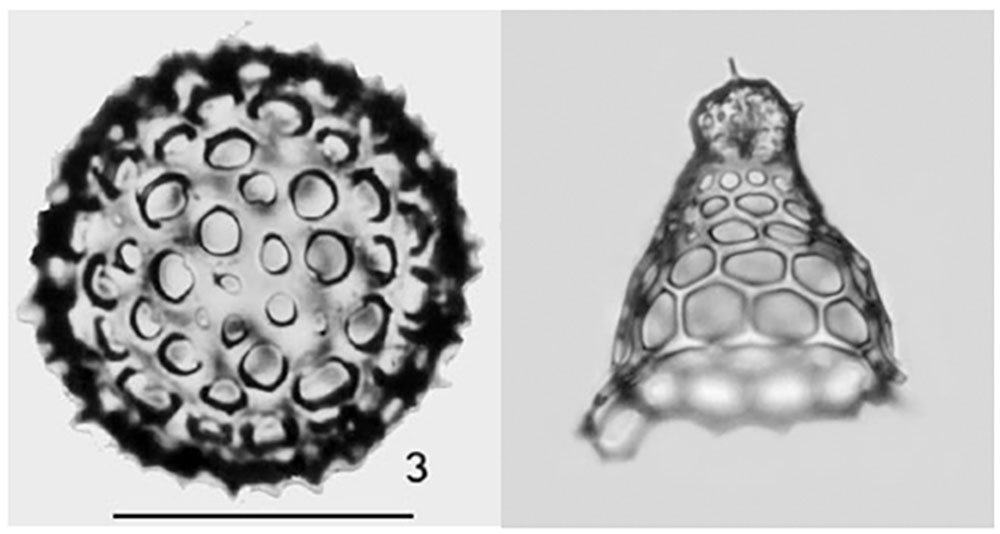Revising the phytoplankton pCO2 proxy
Because marine algae (phytoplankton) require CO2 for their growth, they are very sensitive to the concentration of CO2. The carbon isotopic fractionation during algal photosynthesis (Ep) serves as a sensitive indicator of the carbon limitation status of phytoplankton, as it is dependent on the ratio of supply to demand of C for photosynthesis. Determination of carbon isotopic fractionation in fossil organic matter has been proposed as an indicator of past carbon limitation and CO2 availability. This indicator provides most numerous estimates of past atmospheric CO2 concentrations in the Cenozoic.
However, recent studies suggest that revisions are needed in the interpretive framework that forms the basis of phytoplankton pCO2 estimations. Most previous pCO2 estimates assumed that carbon uptake by the cell was only diffusive, in contrast to research over the last several decades which reveals that supplementary mechanisms of concentrating carbon (CCMs) at the active site of photosynthesis are ubiquitous and affect the photosynthetic carbon isotopic fractionation. This incomplete application of understanding of cellular C allocation leaves many of the absolute CO2 concentrations, and some trends, subject to revision.
We are working to update the interpretive framework for pCO2 estimation through several approaches. Firstly, we are working to develop an improved knowledge of cellular carbon uptake mechanisms and detailed process models (see section adaptation and carbon acquisition in coccolithophores).
Secondly, in our new algal culture facilities, we will be undertaking new culture experiments in conditions which more closely match those which occur during algal growth in modern and past oceans. The photobioreactor system will allow a high level of control over culture conditions, including light cycles. The real-time continuous monitoring of culture media d13C of DIC will ensure a higher level of accuracy in estimations of carbon isotopic fractionation in both organic matter and coccoliths than attained previously. Our recent recalibration of the relationship between carbon isotopic fractionation and CO2 from statistical evaluation of all published culture data highlighted some important experimental data gaps which can be addressed by targeted culture studies.
An important dimension of our work, led by Ivan Hernandez, is the estimation of past variations in algal growth rates. We are collaborating with ocean biogeochemical modelers in the group of Niki Gruber (Environmental Science, ETH) to incorporate recent advances in the modeling of phytoplankton growth rates, with observations of phytoplankton fractionation in the photic zone. These evalutions reveal important limitations in the use of a single proportionality coefficient “b” between isotopic fractionation and CO2 aq concentrations, and confirm that growth rate is not the principal regulator of “b” in the modern ocean. We are also testing micropaleontological and geochemical proxies for phytoplankton growth rate. These could be applied along with past estimates of phytoplankton fractionation to produce more accurate pCO2 determinations.

This project is supported by the Swiss National Science Foundation and ETH internal funding.
Publications
Stoll, H., Guitian, J., Hernández Almeida, I., Mejia, L. M., Phelps, S., Polissar, P., Rosenthal, Y., Zhang, H., & Ziveri, P.; Upregulation of phytoplankton carbon concentrating mechanisms during low C02 glacial periods and implications for the phytoplankton pCO2 proxy. (Quaternary Science Reviews)
Hernadez-Almeida, I., Saavedra-Pellitero, M., Ausin, B., Baumann, K.-H., & Stoll, H.; Coccolithophore ecology and primay productivity in low latitudes during the last glacial maximum and the mid-to-late Holocene.(Quaternary Science Reviews)
Hernandey Almeida, I., Krumhardt, K., Nissen, C., Gruber, N., & Stoll; H.; Proxies for coccolithophore growth rate and the applicability of the 'b' term for alkenone CO2 reconstructions. (Earth and Planetary Science Letters)
Contact
Deputy head of Geological Institute
Professur für Klimageologie
Sonneggstrasse 5
8092
Zürich
Switzerland
